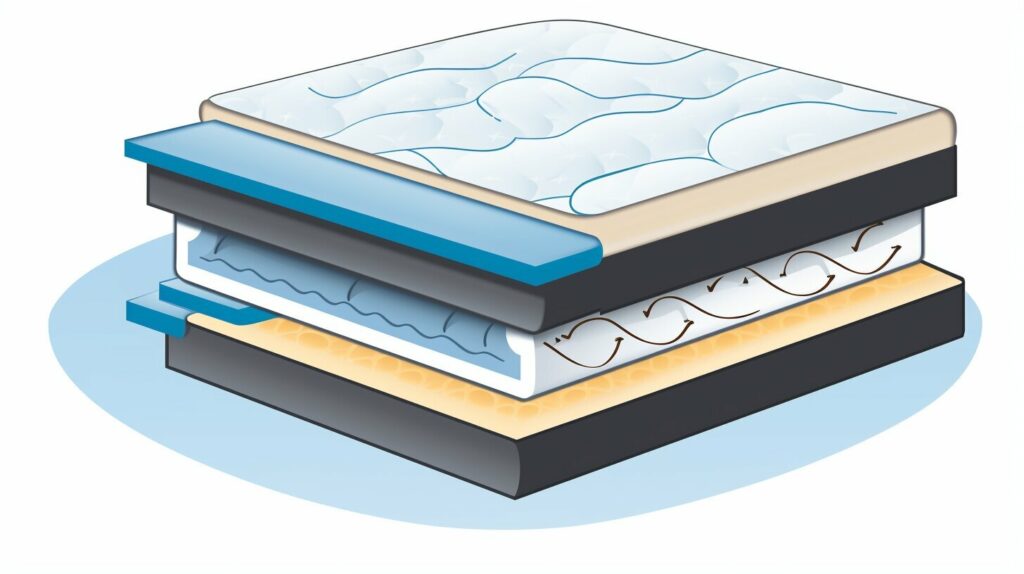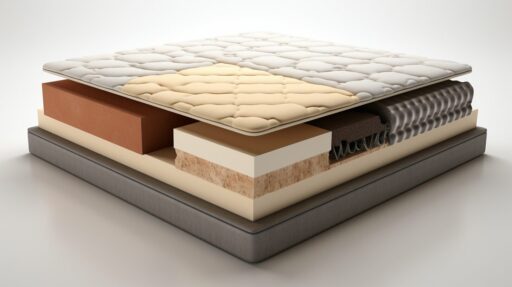Finding the right mattress can feel overwhelming. Start your search by using our mattress quiz below, which will help determine your best bed based on sleep position, body weight, and other key factors. Experts agree that getting good sleep is one of the single best ways to maintain and improve your health. A mattress is a huge factor in your ability to sleep well, yet many people overlook its importance and keep using a mattress that fails to provide enough support and comfort. A new mattress can be a sizable investment, but taking this step can unlock your ability to sleep better.
Key Takeaways:
- Consider using a mattress quiz to help determine the best bed for your sleep needs.
- A good mattress is essential for quality sleep and overall health.
- Investing in a new mattress can significantly improve your sleep quality.
- Don’t overlook the importance of finding a mattress that provides adequate support and comfort.
- Getting a good night’s sleep is worth the investment in a new mattress.
How to Choose the Perfect Mattress Type for Your Sleep Style
When it comes to choosing a mattress, your sleep style is an important factor to consider. Different mattress types are better suited for different sleep positions. By understanding your sleep style and its specific needs, you can make an informed decision and find the perfect mattress for a good night’s sleep.
Back Sleepers
Back sleepers generally need medium-firm mattresses that offer support and spine alignment. These mattresses help distribute body weight evenly and maintain a neutral spine position. Look for mattresses with a combination of support and comfort to ensure a restful sleep experience.
Side Sleepers
Side sleepers benefit from softer mattresses that provide pressure relief for the shoulders and hips. These mattresses allow for better contouring to the body’s curves, reducing the risk of pain and discomfort. Look for mattresses with good cushioning and support to enhance your sleep quality.
Stomach Sleepers
Stomach sleepers need firm mattresses to prevent sagging of the spine and maintain proper alignment. These mattresses provide support to keep the body in a neutral position and prevent lower back pain. Look for mattresses with a firmer feel and good support to ensure a comfortable sleep for stomach sleepers.
Combination sleepers who switch positions frequently can opt for a mattress with medium firmness that provides a balance of support and comfort. Take into consideration your sleep style and preferences when choosing a mattress to ensure optimal sleep quality and satisfaction.

| Matress Type | Features | Pros | Cons |
|---|---|---|---|
| Foam Mattress | Contouring, pressure relief, motion isolation | – Relieves pressure points – Molds to the body – Good motion isolation | – Can retain heat – May have a chemical odor initially |
| Innerspring Mattress | Coil-based support, bouncier sleeping surface | – Durable – Strong edge support – Good airflow | – Less contouring – Potential for noise and motion transfer |
| Hybrid Mattress | Coils with foam or latex, support and contouring | – Responsive – Combination of materials – Good support and contouring | – Can be more expensive – Potential for motion transfer |
| Latex Mattress | Bounce, durability, moderate contouring | – Natural hypoallergenic properties – Good airflow – Durable | – Can be expensive – Limited contouring |
| Airbed Mattress | Adjustable firmness with air chamber | – Customizable firmness – Suitable for couples with different preferences | – Potential for air leaks – Requires maintenance |
Factors to Consider When Choosing a Mattress
When it comes to choosing a mattress, there are several important factors to consider. These factors can greatly impact your sleeping experience and ensure that you find a mattress that meets your specific needs. Below, we will explore four key factors: mattress firmness, mattress support, mattress materials, and mattress durability.
Firmness
One of the most crucial aspects to consider when selecting a mattress is firmness. Mattress firmness refers to how soft or firm a bed feels when you lie on it. The level of firmness you choose should be based on your sleep position and body weight. Generally, side sleepers benefit from a softer mattress that provides adequate contouring and pressure relief for the shoulders and hips. Back sleepers usually require a medium-firm mattress that offers support and maintains proper spinal alignment. Stomach sleepers need a firmer mattress to prevent the spine from sinking. By considering your sleep position and body weight, you can find the right level of firmness for optimal comfort and support.
Support
The level of support offered by a mattress is another important consideration. A mattress should provide proper spinal alignment and pressure relief, ensuring that your body is adequately supported during sleep. Different mattress types and materials offer varying levels of support. Innerspring mattresses with a coil-based support system tend to be bouncier and provide more support. Foam mattresses, on the other hand, offer contouring and motion isolation. Hybrid mattresses combine the benefits of both foam and innerspring, providing a balance of support and comfort. It’s essential to choose a mattress that aligns with your specific support needs to promote healthy and restful sleep.
Materials
The materials used in a mattress can greatly affect its performance and comfort. Different materials have different properties, such as temperature regulation, motion isolation, and allergen resistance. Foam mattresses, for example, are known for their contouring and pressure-relieving properties, while latex mattresses offer durability and bounce. Hybrid mattresses combine multiple materials to provide a balance of support and comfort. Consider your preferences and needs when it comes to mattress materials, taking into account factors such as breathability and environmental impact.
Durability
Durability is an essential factor to consider when investing in a mattress. A mattress is a long-term investment, and you want to ensure that it will last for years to come. Look for mattresses that are made with high-quality materials and construction techniques. Consider factors such as the warranty and reviews from other customers to gauge the durability of a mattress. By choosing a durable mattress, you can rest assured that your investment will provide you with comfortable and restful sleep for an extended period.

With these factors in mind, choosing the right mattress becomes a more informed and personalized decision. By considering mattress firmness, support, materials, and durability, you can find a mattress that suits your sleep needs and preferences, ensuring a comfortable and restful night’s sleep.
Choosing the Right Mattress for Back Pain Relief
If you suffer from back pain, finding the right mattress can make a world of difference in your sleep quality and overall comfort. The best mattress for back pain will depend on the nature and location of your pain. Here are some recommendations:
Mattress for Lower Back Pain
If you experience lower back pain, it’s important to choose a mattress that offers medium firmness and excellent support. A mattress that is too soft may not provide enough support for your lower back, while a mattress that is too firm can cause additional discomfort. Look for a mattress that strikes the right balance, providing support and contouring to alleviate pressure on your lower back.
Mattress for Upper Back Pain
For those with upper back pain, a mattress that offers pressure relief and promotes spinal alignment is key. Look for a mattress that provides adequate support for your shoulders and neck, while still allowing for proper contouring. A medium-firm mattress with good responsiveness can help alleviate upper back pain and improve your sleep quality.
Mattress for Overall Back Pain Relief
If you experience back pain throughout your entire back, it’s important to find a mattress that addresses multiple areas of discomfort. Consider a mattress that offers a combination of support, pressure relief, and contouring. Look for a mattress that provides adequate support for your spine, while still allowing for proper cushioning and pressure relief in sensitive areas.
| Back Pain Location | Recommended Mattress |
|---|---|
| Lower Back Pain | Medium-firm mattress with excellent support |
| Upper Back Pain | Pressure-relieving mattress that promotes spinal alignment |
| Overall Back Pain | Combination of support, pressure relief, and contouring |
Remember, finding the right mattress for your back pain may involve some trial and error. Look for mattresses with generous return policies or sleep trials, giving you the opportunity to test the mattress and ensure it provides the necessary comfort and support. By investing in a mattress that specifically targets your back pain, you can take a significant step towards relieving discomfort and achieving a restful night’s sleep.
The Importance of Choosing the Right Mattress for Sleep Position
Your sleep position plays a significant role in determining the type of mattress that will provide optimal comfort and support. Whether you are a side sleeper, back sleeper, or stomach sleeper, selecting a mattress that caters to your sleep position can enhance your sleep quality and overall comfort.
Mattress for Side Sleepers
If you are a side sleeper, you need a mattress that offers pressure relief for the shoulders and hips. A softer mattress with good contouring can help alleviate pressure points and promote proper spinal alignment. Look for mattresses that provide cushioning and support to ensure a comfortable sleep experience.
Mattress for Back Sleepers
Back sleepers require a mattress that maintains proper spinal alignment and offers medium-firm support. This type of mattress helps distribute body weight evenly, preventing any strain on the lower back. Look for mattresses with supportive layers and a balanced level of firmness to ensure a restful night’s sleep.
Mattress for Stomach Sleepers
Stomach sleepers benefit from a firmer mattress that prevents sinking of the spine. This helps keep the spine aligned and reduces the risk of discomfort or pain. Look for mattresses that provide adequate support and firmness, ensuring a comfortable and supportive sleep surface.
By selecting a mattress that caters to your specific sleep position, you can enhance your sleep quality, alleviate pressure points, and wake up feeling refreshed and rejuvenated.
Factors to Consider When Buying a Mattress for Couples
When it comes to choosing a mattress for couples, there are a few key factors to keep in mind to ensure both you and your partner enjoy a restful night’s sleep. One important consideration is motion isolation. You want a mattress that minimizes motion transfer, so you won’t be disturbed by your partner’s movements throughout the night. Look for a mattress specifically designed for motion isolation or one that utilizes materials and construction techniques to reduce motion transfer.
Additionally, it’s crucial to take both you and your partner’s comfort preferences into account. Different individuals may have different firmness preferences, so it can be beneficial to find a mattress that caters to both. Some mattresses offer customizable firmness options, allowing each side of the bed to be adjusted independently. This way, you and your partner can find a firmness level that suits your individual needs.
Finally, consider the size of the mattress. While a Queen or King-size bed is often recommended for couples, it ultimately depends on your personal preferences and the space available in your bedroom. Make sure to measure your room and consider your sleeping habits to determine the best size for you and your partner.
Table: Comparison of Top Mattresses for Couples
| Mattress Brand | Motion Isolation | Customizable Firmness | Available Sizes |
|---|---|---|---|
| Brand A | Excellent | Yes | Queen, King |
| Brand B | Good | Yes | Queen, King, California King |
| Brand C | Very Good | No | Queen, King |
| Brand D | Excellent | No | Queen, King, California King |
Table: Comparison of top mattresses for couples, showcasing motion isolation, customizable firmness options, and available sizes.
By considering these factors and finding a mattress that caters to both you and your partner’s needs, you can create a sleep environment that promotes comfort and supports a good night’s rest for both of you.
The Importance of Cooling in a Mattress
When it comes to getting a good night’s sleep, temperature plays a crucial role. If you’re a hot sleeper or live in a warm climate, a cooling mattress can be a game-changer. A cooling mattress is designed to dissipate body heat and promote airflow, keeping you comfortable throughout the night. By investing in a mattress that prioritizes cooling technology, you can say goodbye to sweaty nights and hello to a more restful sleep.
So, what makes a cooling mattress the best choice for hot sleepers? These mattresses are often made with breathable materials that allow air to circulate freely, preventing the buildup of heat. Additionally, some cooling mattresses feature gel-infused foam, which helps regulate temperature by absorbing excess heat. Others use phase change materials that actively absorb and release heat, ensuring a cool and comfortable sleep environment.
“A cooling mattress can improve your sleep quality and prevent discomfort caused by overheating during the night.”
Not only do cooling mattresses keep you comfortable, but they also promote better sleep quality. Research has shown that a cooler sleeping environment can help you fall asleep faster and experience fewer disturbances throughout the night. By reducing the tendency to toss and turn due to discomfort, a cooling mattress can help you wake up feeling more refreshed and rejuvenated.
The Benefits of a Cooling Mattress
- Regulates body temperature for a cooler sleep experience
- Prevents discomfort and excessive sweating
- Promotes better sleep quality and fewer sleep interruptions
- Reduces the need to toss and turn during the night
- Improves overall sleep comfort and rejuvenation
| Brand | Model | Cooling Technology | Price |
|---|---|---|---|
| Brand A | CoolSleep | Gel-infused foam | $1,299 |
| Brand B | ChillRest | Phase change materials | $1,599 |
| Brand C | CoolDreams | Open-cell technology | $1,199 |
With so many options available, how do you choose the best cooling mattress? Consider factors such as cooling technology, price, and customer reviews. Look for mattresses that provide effective cooling features without compromising on comfort and support. Reading customer reviews can also give you insights into real-life experiences with the mattress’s cooling capabilities.
Investing in a cooling mattress can have a significant impact on your sleep quality and overall well-being. Say goodbye to sleepless, sweaty nights and hello to a cooler and more comfortable sleep environment. Experience the benefits of a cooling mattress for yourself and enjoy a restful night’s sleep.
Considerations for Choosing a Mattress for Children
When it comes to choosing a mattress for your children, there are a few important considerations to keep in mind. Children have unique needs when it comes to sleep and their growing bodies require proper support and comfort. Here are some factors to consider when selecting the best mattress for kids:
- Firmness: It’s important to choose a mattress with the right level of firmness for your child’s age and weight. A mattress that is too soft may not provide adequate support, while a mattress that is too firm can be uncomfortable.
- Safety: Look for mattresses that are made from hypoallergenic materials and are free from harmful chemicals. This will help create a safe sleeping environment for your child and reduce the risk of any allergies or respiratory issues.
- Growth and Development: A mattress that provides proper spinal alignment and support is essential for your child’s growth and development. Look for mattresses that promote healthy posture and offer sufficient support for their growing bodies.
By considering these factors, you can ensure that your child gets the best possible sleep and wakes up feeling rested and refreshed every morning. Investing in a high-quality mattress for your child is a decision that will benefit them for years to come.
Mattress Toppers for Added Comfort and Support
Are you looking to enhance the comfort and support of your current mattress without breaking the bank? Look no further than mattress toppers. These additional layers of cushioning can be a game-changer for a better night’s sleep. Whether you want to add extra pressure relief, contouring, or support, mattress toppers offer a simple and affordable solution.
“Adding a mattress topper is like giving your mattress a makeover. It can transform an average bed into a luxurious sleep haven.” – Sleep Expert
The Benefits of Mattress Toppers
There are several key benefits to using a mattress topper. One of the main advantages is the added comfort it provides. Toppers can offer an extra layer of plushness or firmness, depending on your preference. They can also help alleviate pressure points, reducing the chances of waking up with aches and pains.
Mattress toppers are also an excellent option for those who want to extend the life of their current mattress. If your mattress is getting old or showing signs of wear, a topper can help rejuvenate it and add a few more years of use. It’s a cost-effective way to enjoy the benefits of a new mattress without the hefty price tag.
Choosing the Best Mattress Topper
When selecting a mattress topper, there are a few factors to consider. Firstly, determine your primary sleep needs. Are you looking for extra softness, support, or both? Consider your sleep position, body weight, and any specific issues you want to address, such as back pain or pressure relief.
| Topper Type | Benefits | Best For |
|---|---|---|
| Memory Foam | Conforming comfort, pressure relief | All sleep positions, especially side sleepers |
| Latex | Bouncy support, natural cooling | All sleep positions, especially hot sleepers |
| Down Feather | Softness, breathability | Side and back sleepers, colder climates |
| Wool | Natural temperature regulation, moisture-wicking | All sleep positions, allergy sufferers |
Lastly, consider factors such as durability, hypoallergenic properties, and ease of maintenance when choosing a mattress topper. Look for reputable brands that offer high-quality materials and a good warranty. With the right mattress topper, you can take your sleep experience to a whole new level of comfort and support.
Tips for Buying a Mattress Online
Buying a mattress online offers convenience and a wide range of options. To ensure a seamless online mattress shopping experience, consider the following tips:
- Research and read reviews: Before making a purchase, research different mattress brands and models. Read customer reviews to gain insights into the quality, comfort, and durability of the mattresses you’re interested in.
- Check customer ratings: Look for mattresses with high customer ratings. These ratings are typically based on factors like comfort, support, and customer satisfaction. Higher ratings indicate a better overall experience.
- Review return policies: It’s important to understand the return policies of the online mattress retailers you’re considering. Look for companies that offer a risk-free trial period with a full refund if you’re not satisfied with the mattress.
- Consider mattress-in-a-box delivery: Many online mattress companies offer mattress-in-a-box delivery. This means the mattress is compressed, rolled, and shipped directly to your doorstep. Make sure you have a clear understanding of the delivery process and any additional fees involved.
By following these tips, you can confidently navigate the online mattress shopping landscape and find a mattress that meets your specific needs and preferences.
Customer Testimonials
“I was hesitant about buying a mattress online, but the customer reviews and return policy gave me the confidence to make a purchase. I’m so glad I did! The mattress arrived quickly, and it’s incredibly comfortable. Best sleep I’ve had in years!” – Jane S.
“Shopping for a mattress online was so convenient. I was able to compare different options, read reviews, and make a decision from the comfort of my own home. The mattress-in-a-box delivery was a breeze, and the return policy gave me peace of mind. Highly recommend!” – Mark T.
Comparison of Online Mattress Retailers
| Retailer | Customer Ratings | Return Policy | Mattress-in-a-Box Delivery |
|---|---|---|---|
| Company A | 4.5/5 | 100-night risk-free trial | Yes |
| Company B | 4/5 | 365-night risk-free trial | Yes |
| Company C | 4.2/5 | 90-night risk-free trial | Yes |
Conclusion
Choosing the right mattress is crucial for a good night’s sleep and overall well-being. By considering factors like sleep position, support, firmness, and materials, you can find the perfect mattress that suits your needs.
There are various types of mattresses available, including foam, innerspring, hybrid, latex, and airbed mattresses. Each type has its own pros and cons, so it’s important to assess your preferences and needs before making a decision.
Additionally, don’t forget to explore mattress options like mattress toppers, which can provide added comfort and support to enhance your sleep experience. These toppers come in different materials and thicknesses, allowing you to customize your bed according to your preferences.
With the convenience of online mattress shopping, you can easily find a mattress that meets your requirements. Take advantage of mattress reviews, customer ratings, and return policies to make an informed decision. By following this mattress buying guide, you can invest in a mattress that will provide you with years of restful sleep. Sweet dreams!
FAQ
What is the best type of mattress for me?
The best type of mattress for you depends on your sleep position, body weight, and other factors. Take our mattress quiz to find your perfect bed.
What types of mattresses are available?
There are five main types of mattresses: foam, innerspring, hybrid, latex, and airbed. Each type has its own pros and cons.
How do I choose the right mattress firmness?
The right mattress firmness depends on your sleep position and body weight. Back sleepers generally need medium-firm mattresses, side sleepers benefit from softer mattresses, and stomach sleepers need firmer mattresses.
What factors should I consider when buying a mattress?
When buying a mattress, consider factors like support, materials, temperature regulation, motion isolation, and durability.
What is the best mattress for back pain relief?
The best mattress for back pain depends on the nature and location of the pain. Generally, a mattress with medium firmness and support is recommended.
What type of mattress is best for side sleepers?
Side sleepers benefit from a mattress that offers pressure relief for the shoulders and hips, such as a softer mattress with good contouring.
What factors should I consider when buying a mattress for couples?
When buying a mattress for couples, consider factors like motion isolation and customization options for different firmness preferences.
How can I choose a mattress that keeps me cool at night?
Look for mattresses with cooling features like breathable materials, gel-infused foam, or phase change materials that absorb and release heat.
What should I consider when choosing a mattress for children?
When choosing a mattress for children, prioritize factors like support, durability, and safety. Look for appropriate firmness based on age and weight, hypoallergenic materials, and chemical-free options.
How can I enhance the comfort of my current mattress?
Consider adding a mattress topper, which can provide extra cushioning, pressure relief, and support.
What should I know when buying a mattress online?
When buying a mattress online, consider factors like mattress reviews, customer ratings, return policies, and detailed product descriptions. Look for risk-free trial periods and hassle-free returns.





















